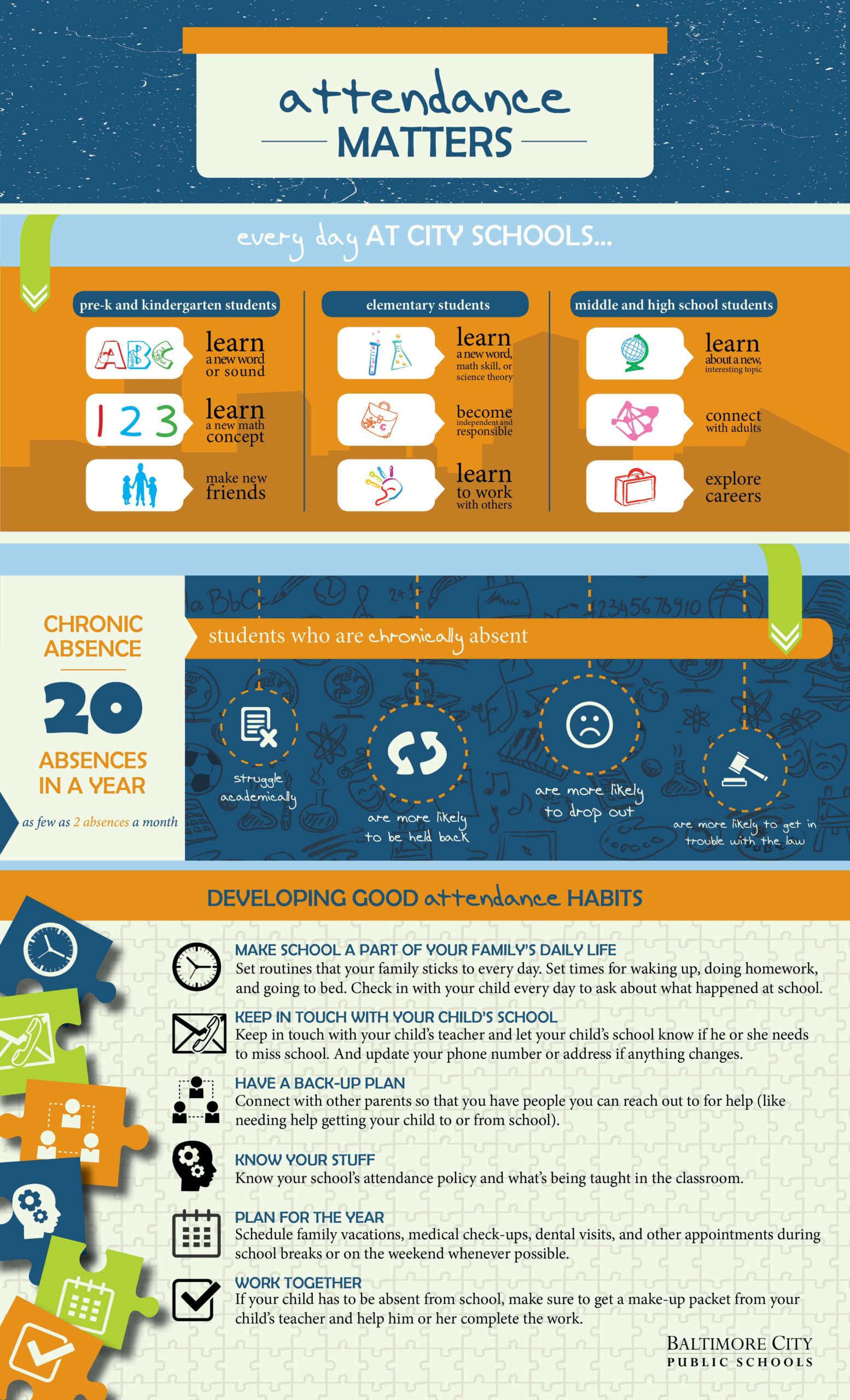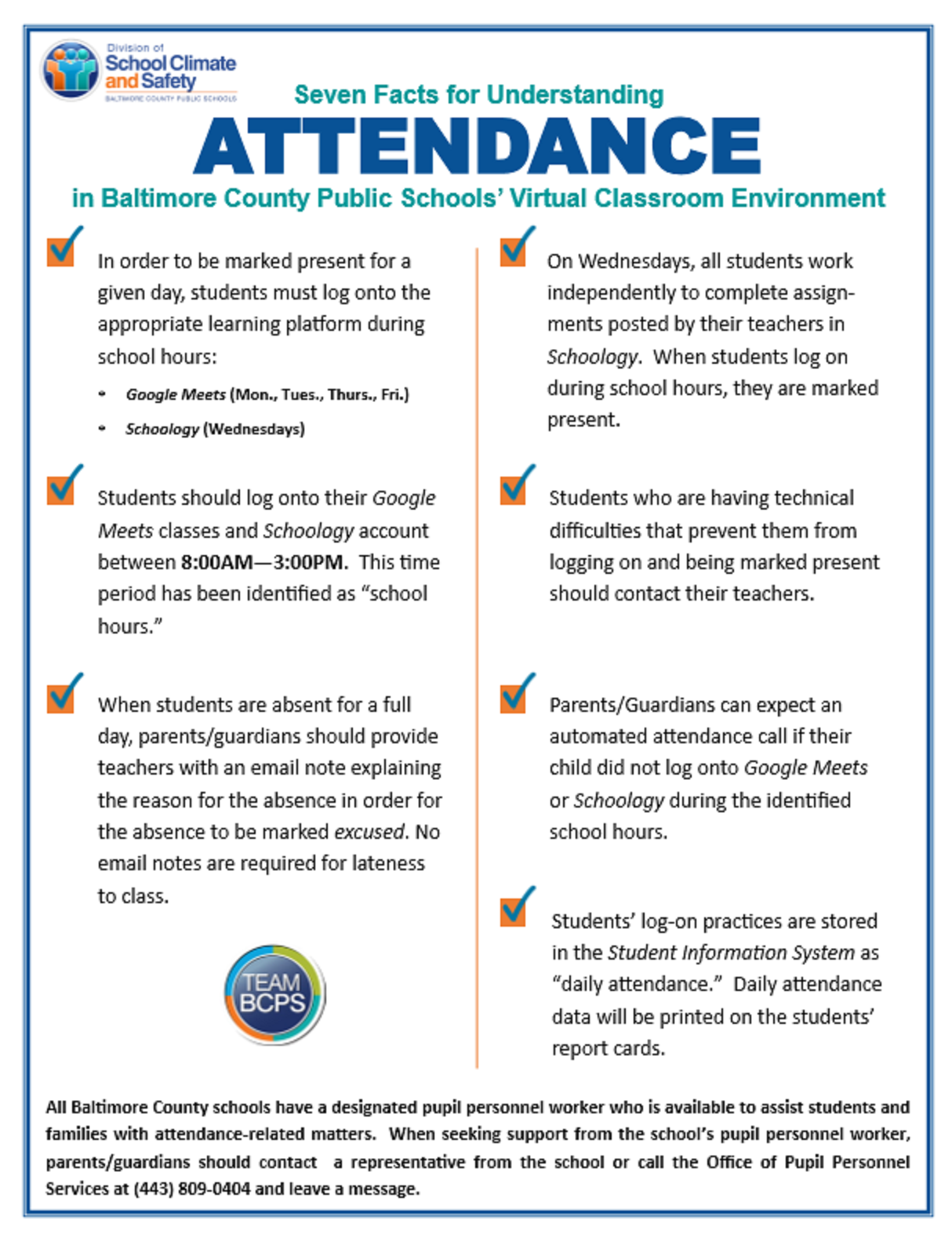Daily attendance in school is critical for young people’s academic success. Students with a strong attendance record are also more likely to have positive long-term outcomes in areas such as college graduation, employment, and physical and mental health.
Here at GHEMS, we are making student attendance a high priority this school year, especially during periods of distance learning.
The following FAQ is intended to answer questions families may have regarding attendance expectations and procedures during distance learning. If you have additional questions or concerns related to attendance, please contact GHEMS directly.

How often must my student participate in distance learning to be marked present?
All students are expected to attend school five days a week and to attend all classes in which they are enrolled each day.
What if my child misses a full or partial day of school during distance learning?
Unless a family has made arrangements to participate in asynchronous learning for that day, the parent/guardian must submit a written note to the school, providing a legally recognized justification for the absence. This note may be submitted by email. Absences are considered “excused” for the following reasons:
- Student illness (a doctor’s note is required after a student is absent 3 days or more days in a row)
- A death in the immediate family
- Court summons (with the child’s name on the summons)
- Religious holiday
- Official school closing
- Work or other activity sponsored and approved by the school
- Suspension
- Lack of authorized, district-provided transportation
- Pregnancy and/or parenting needs (student)
- Other emergency as determined by City Schools’ CEO or designee
Also, please note that students who are absent from virtual learning due to not having a computer or Internet connection will not be held accountable for the day(s) missed for this reason. Please see #7 below for more information.
Students who do not attend school and do not provide a written note or email with a legally recognized reason for their absence will be marked absent and every effort will be made to find, support, and re-engage them
What if it is not possible for my child to participate in live virtual sessions learning sessions led by a teacher during the day, but we want them to make it up later? Can my student be marked as present for that day?
What if it is not possible for my child to participate in live virtual sessions learning sessions led by a teacher during the day, but we want them to make it up later? Can my student be marked as present for that day?
If a student misses the synchronous (live virtual learning) sessions for one or more classes in a day but wants to make up for those classes by taking part in asynchronous learning (the student learning on their own) on that day, the parent/guardian must submit a written note to the student’s teacher(s) to request attendance credit for the student’s participation in asynchronous learning. This note may be submitted by email. The family must receive approval in writing from the student’s teacher(s).
Evidence provided to document participation in asynchronous learning must be in response to a task(s) provided by the student’s teacher(s). Evidence must be submitted for each class missed by no later than the beginning of that class on the next school day
If our family has extenuating circumstances that make it difficult for our child to participate in synchronous (live) sessions on an on-going basis, what should we do?
If our family has extenuating circumstances that make it difficult for our child to participate in synchronous (live) sessions on an on-going basis, what should we do?
If a student and/or family have a longer-term conflict or challenge that prevents a student from participating in synchronous learning for an extended period of time, the family should discuss this issue with the student’s teacher(s). The family should then submit a written request to the teacher(s) (an email is sufficient) to ask that the student be allowed to provide evidence of participation in asynchronous learning each day as confirmation of the student’s attendance. The family must receive approval in writing from the relevant teacher(s). The request and approval will be preserved in the student’s attendance record.
Evidence provided to document participation in asynchronous learning must be in response to a task(s) provided by the student’s teacher(s). Evidence must be submitted for each class missed by no later than the beginning of that class on the next school day.
What happens if my child needs to come late to school or has to leave early?
When a late arrival or early dismissal can’t be avoided, a written note should be emailed to the teacher that school day. Whenever possible, parents and guardians should schedule children’s medical and other appointments outside of school hours.
How will attendance be recorded daily?
Teachers will enter attendance into the student information system each day (Infinite Campus program). Attendance will be taken every day for all students.
Elementary and middle schools will take attendance at the beginning of the day and again after lunch. In the event a student does not return in the afternoon, the student will be recorded as attending for a half day and contact will be made with the home to ensure the student’ safety.
Secondary schools will take attendance by class period, as usual. This includes Wednesday lab days.
What if my child does not yet have a Chromebook or other computer and is unable to participate in virtual learning—will they be marked absent?
If your child does not have a computer or is unable to connect to the Internet, please immediately contact your child’s school and make sure they are aware of your need. Students who are unable to attend virtual classes because they do not yet have a computer or cannot connect to the Internet will not be marked absent.
Developing good attendance habits
Make school part of your family’s daily life
Set routines that your family sticks to every day and make sure the children in your family follow them. Have specific times for waking up, starting homework, and going to bed. Check in with your child in the evening to ask about her or his day at school.
Keep in touch with your child’s school
Maintain contact with your child’s teachers to keep up with what’s being taught and to keep an eye on your child’s progress; you can also check your child’s attendance through Parent Portal. Be sure to let your child’s school know when he or she needs to miss school. And, don’t forget to update your contact information with your child’s school if your phone number or address changes.
Have a back-up plan
Connect with other parents or members of your community to make a list of people you can reach out to for help for days that things don’t go according to plan (and you need help with things like getting your child to or from school).
Know your stuff
Know your child’s school’s attendance policy and what’s being taught in the classroom.
Plan for the year
Check the district’s yearlong calendar and schedule family vacations, medical check-ups, dental visits, and other appointments during school breaks or the weekend whenever possible.
Work together
Help your child with homework to show you care about school success. And, if your child has to be absent from school, make sure to get a make-up packet from your child’s teacher and complete the work together (or ask a family member or friend to help out).


Excused and unexcused absences
Children between the ages of 5 and 18 must attend school — it’s the law. But there are times when an absence is unavoidable.
In Maryland, an absence is considered excused once the parent or guardian provides a note explaining that it was due to one of these reasons:
- Death in the immediate family (a parent note is acceptable)
- Illness (a parent note is acceptable for an illness up to three days; a doctor’s note is required for illnesses lasting longer than three days)
- Court summons (the student’s name must appear on the summons)
- Hazardous weather conditions (a parent note is acceptable)
- Observance of a religious holiday (a parent note is acceptable)
In addition, absences for these reasons are considered excused and do not require documentation:
- School-approved activities or work
- Suspension
- Lack of authorized school transportation
- District- or schoolwide closings due to inclement weather or other emergency conditions
According to state law, an absence for any other reason is considered unexcused.
Chronic absence and truancy
Chronic absence
Students who are absent for 10% or more of school days (if they were expected to attend for at least ten days) are considered chronically absent and struggle to keep up in school. For example, a student who is registered to attend school for 30 days but is absent 3 of those 30 days is considered chronically absent.
That means that students who miss as few as 5 days a quarter or 2 days a month are at risk of becoming chronically absent and must make every effort to come to school every day to make sure they stay on track.
Truancy
Truancy is a legal term used to identify students who have missed more than 20% of school days (about 3.5 days per month) without a legal reason.
If a student has missed 15 days of school without a legal reason, the school may refer the family to the district office. If the district determines that the school has made every effort to work with the family and offer support but that the student has continued accruing unexcused absences, charges will be filed against the parent or guardian in district court.






